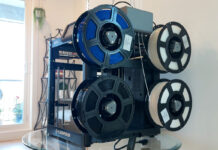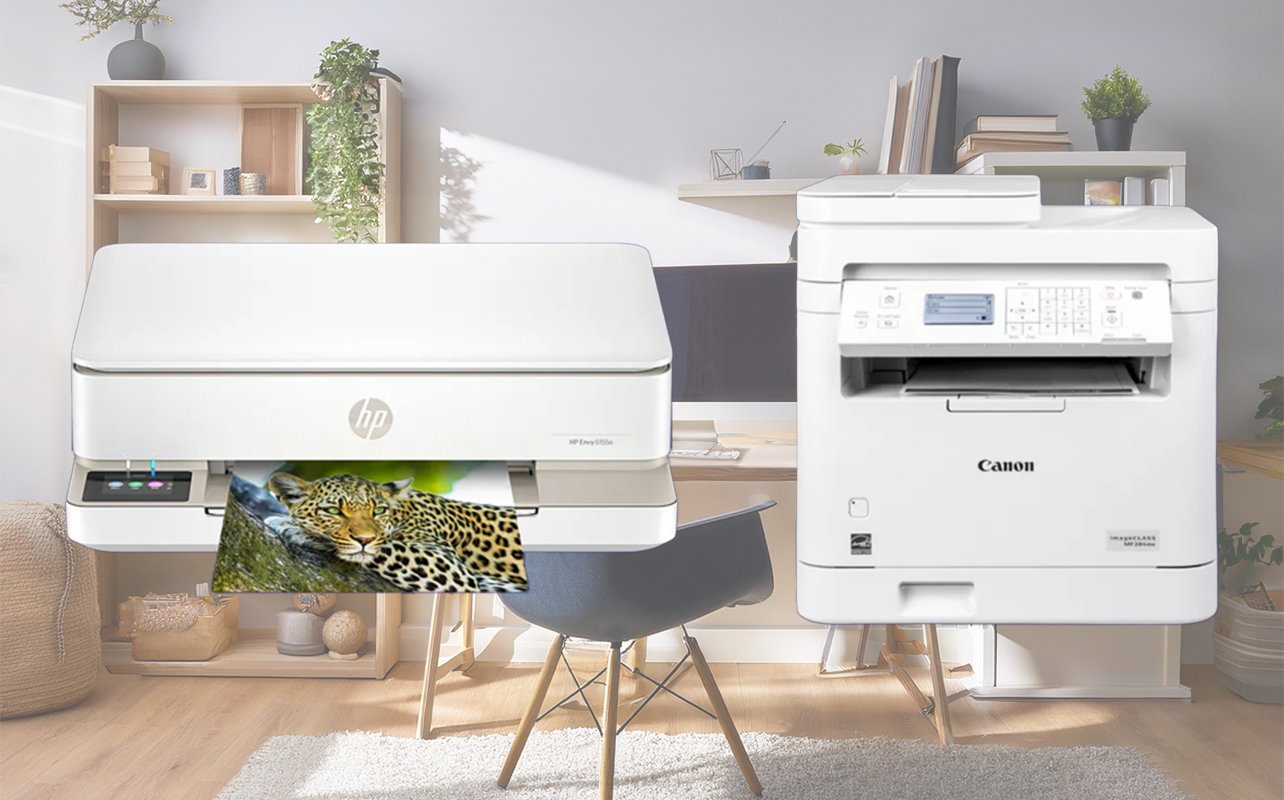
It’s a common debate when thinking about your next printer: do you go with inkjet or laser as the best combination of performance and quality? It’s not an easy choice without taking into account a variety of factors. When you know what you want to do and compare that with what these printers offer, the picture becomes clearer.
There are also some distinctions when assessing an inkjet vs. laser printer. Not every inkjet printer is the same, just as not every laser printer is, either. Are you looking to print in volume or prioritize colour ink for more creative needs? Is it for school or a home office?
Inkjet vs. laser printer at a glance
| Feature | Inkjet printers | Laser printers |
| Print speed | Slower, typically around 5–15 pages per minute | Much faster, generally 20–50 ppm, with high-end models reaching up to 100 ppm |
| Cost per page | Higher – around 5–10¢ for black & white, and 15–25¢ for color | Lower – typically under 5¢ for black & white and around 10–15¢ for color |
| Print quality | Excellent for high-resolution color, photos, and smooth gradients | Outstanding for sharp, clean text; decent graphics, though color reproduction isn’t as vivid as inkjets |
| Upfront price | More affordable initial cost – often starting around $100 or less | Higher upfront investment – usually $200+ depending on model and capabilities |
| Best for | Ideal for occasional use, photo projects, and color-rich tasks in compact setups | Perfect for high-volume text-based printing, offices, and long-term cost efficiency |
What is an inkjet printer?
Inkjet printers work by spraying tiny droplets of liquid ink directly onto paper as it rolls through the feeder. The precision involved is why inkjets are often the preferred choice for printing photos and high-quality colour documents. Because the internal mechanisms doing this are smaller by comparison to laser models, inkjet printers also take up less space. Hence, you’ll have an easier time making room for one in a home office or dorm.
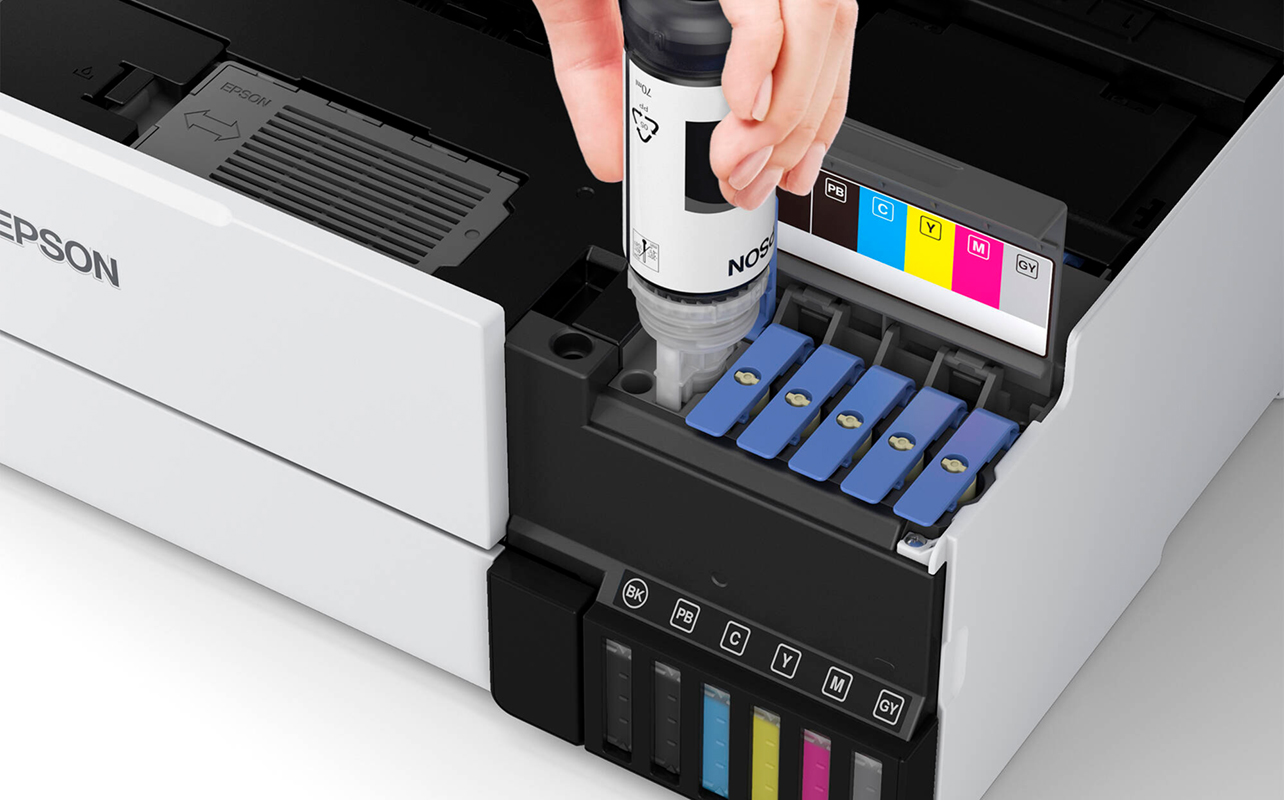
While the underlying technology may be the same, inkjet printers can also differ. Some use replaceable ink cartridges that you slot into a print head. Others use ink tanks, small reservoirs separated by black and colours (cyan, magenta, yellow), to distribute the ink that sprays onto paper. The “spraying” part of the equation isn’t different, it’s simply how the print head pulls in the ink.
The trade-off with an inkjet vs. laser printer is that it’s generally slower, especially when dealing with volume. Ink cartridges and tanks can be expensive to replace, only adding up if you regularly need to print a lot.
What is a laser printer?
Laser printers use a completely different process, where a laser beam creates an electrostatic image on a drum that attracts powdered toner. The toner then fuses to paper through heat. That not only results in crisp and sharp prints, but also instantly dry ink coming out of the printer. This technology works much faster than inkjet printing when we’re talking about high-volume tasks like accounting, legal, or office documents, as well as reports and essays.
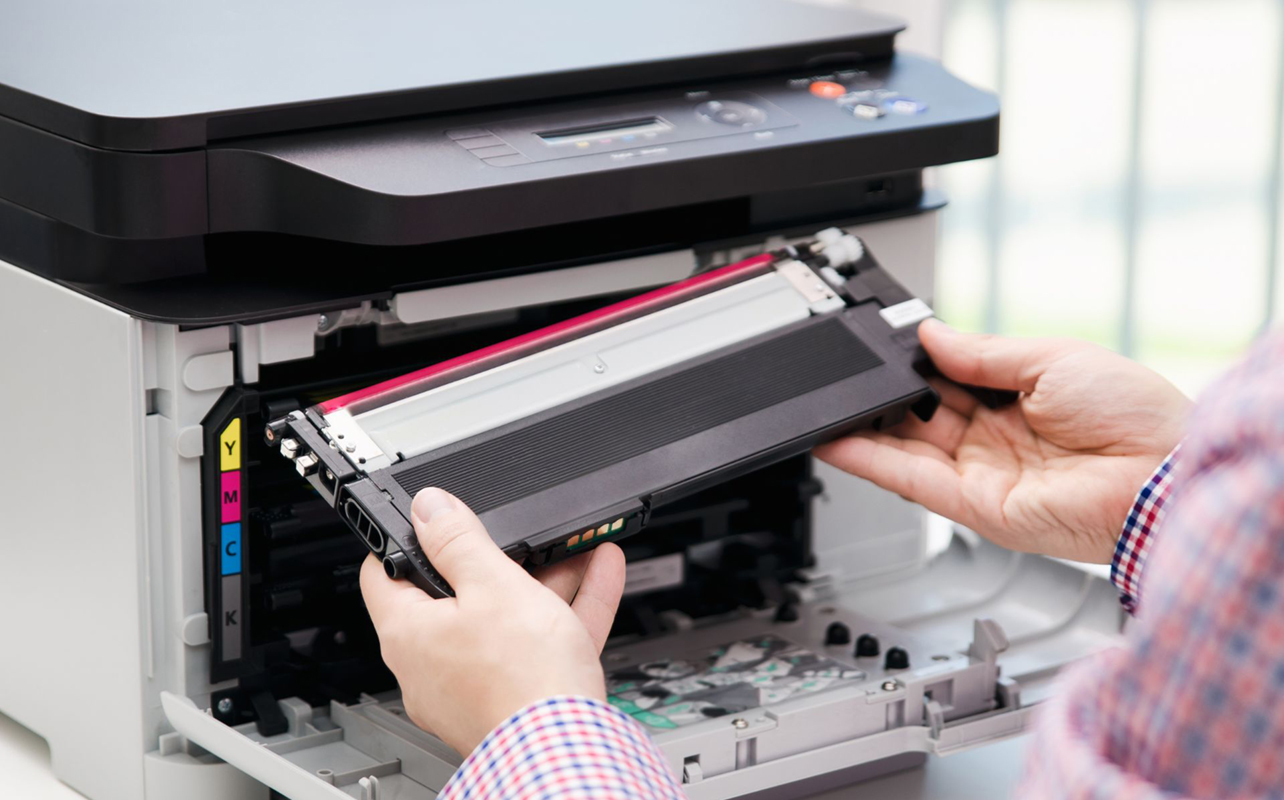
Toner cartridges have excellent longevity, lasting a pretty long time and lowering the cost per page in the long run. The flip side is that the printers themselves tend to be more expensive upfront and also take up more room. Plus, they’re better suited to plain text or spreadsheets, not rich colour photos or prints.
Cost comparison – upfront vs. long-term
You can find inkjet printers for under $100 but there’s a residual cost to think about. The ink cartridges that come in the box are likely smaller “starter” versions of the regular ones. Not only won’t they last as long, but you’ll need to replace all of them. That can add up.
Inkjets with ink tanks are generally much better at cost per page because the ink lasts so much longer. It’s just that you pay a premium for the printer itself. Ink bottle replacements aren’t cheap, either. At the same time, it’s hard to find a better option than inkjet when it comes to printing the highest quality photos.
Laser printers almost always cost more, though price variances are wider than they used to be. Since toner cartridges last much longer, the lower cost per page adds up over time. This makes a lot of sense when volume is a factor, or if text documents make up the vast majority of the output. Toner cartridges aren’t cheap but at least you won’t have to buy them often.
It’s hard to say if one type is more prone to paper jams, but they happen less with laser printers. Even so, you’ll have an easier time dealing with a jam on an inkjet printer because it’s easier to open one up and see where it’s stuck.
Print quality and speed
It’s really no contest when it comes to image quality. An inkjet printer will produce richer colours, smoother gradients, more accurate tones, and higher-resolution prints, making them ideal for photography and design projects. That’s not to say text looks bad on an inkjet. If you’re a student working on projects involving a lot of text, you can still get excellent results on an inkjet.
The difference is that laser printers combine speed and clarity. Text looks fantastic and each sheet comes out far faster by comparison. Those in the accounting or legal fields, where paper volumes can be very high, can attest to how speed and precision save a lot of time. Same with those working in education, healthcare, insurance, and retail. If detailed colour reproduction matters less, then laser might be the way to go.
Best for school use

College students usually live in cramped quarters, like dorm rooms or small apartments, so an inkjet printer’s smaller footprint makes a lot of sense. High school students printing assignments, essays, and some visuals might need a balance between cost and quality. Inkjet printers fit the bill for both, but don’t rule out a budget-friendly laser printer if you’re expecting heavier workloads. It may save you money long-term.
Art and design students have an easy choice in inkjets as the clear winner. Now, there will certainly be differences in the performance and quality from one inkjet printer to another, but if photos and design projects are on tap, pay close attention to those specs and details. STEM students printing lab reports and research papers aren’t likely to need those colour features, so probably benefit more from the speed and efficiency of a laser printer.
Best for everyday home use
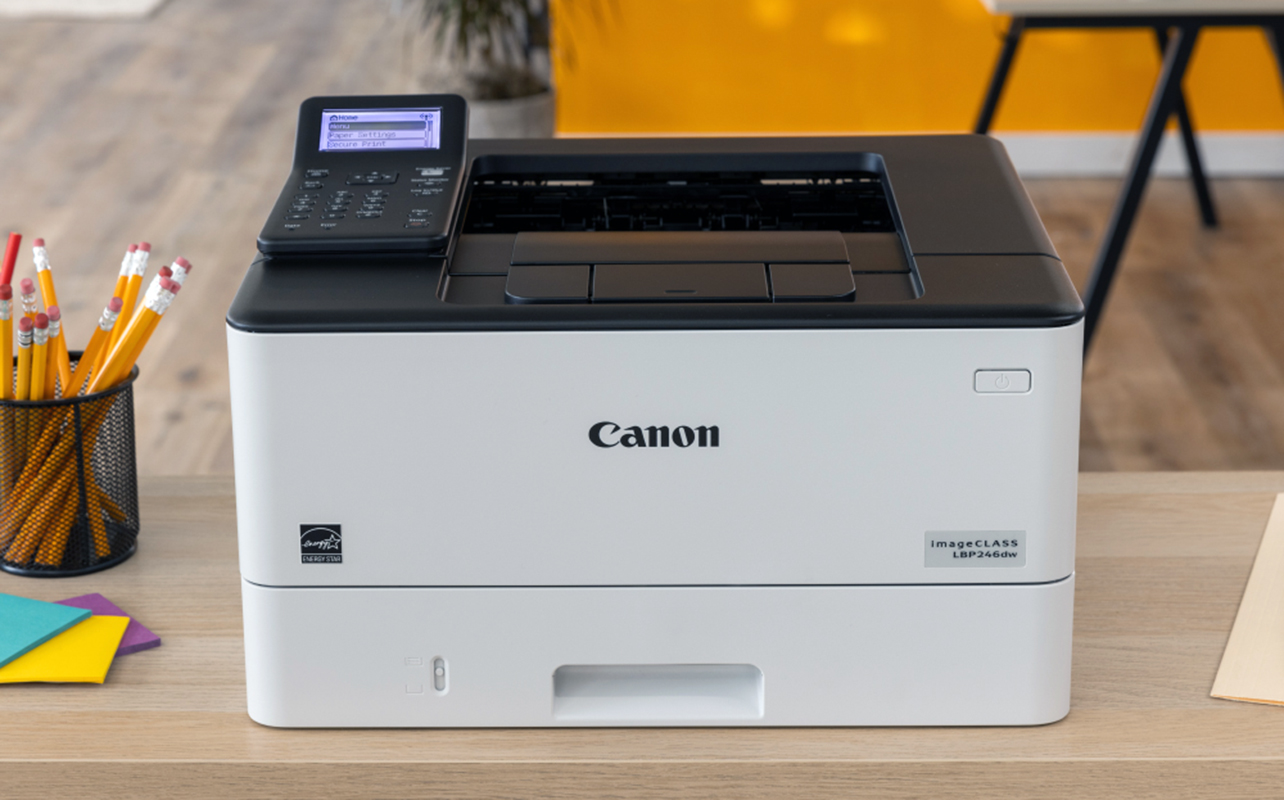
Either printer type can easily handle the average printing task in a household, be it forms, tickets, recipes, shipping labels, or occasional documents. If, at any point, you expect to output some photos or visual projects, you should consider an inkjet printer as the better choice for producing vibrant, true-to-life images.
Laser printers excel with volume, but also multiple users who regularly print documents. It’s an economical choice for shared households since toner lasts longer and reduces the hassle of constantly replacing cartridges.
Just about every inkjet and laser printer available today is Wi-Fi-enabled, so wireless access is straightforward to set up. Doing so means anyone with access to the same network can send files to print. That’s great when sharing a dorm, home office, or living space where a printer can benefit multiple users.
Environmental and space considerations
Laser printers have to warm up to fuse toner onto paper, causing them to generally consume more energy. Inkjets don’t need to warm up to print, so are usually more energy-efficient. Many modern printers now include eco-friendly features like duplex (double-sided) printing and energy-saving sleep modes to offset any excess energy usage. Plus, printers use very little power when sitting idle, making them conveniently available when you need them.
If space is a deciding factor, inkjets are typically smaller and lighter. Easier to move, if necessary, and better suited for cramped dorm rooms or compact home offices. Laser printers are bigger and bulkier, so need more desk or floor space.
Recycling programs for ink cartridges and toner do operate in Canada, and manufacturers may run some of them directly. It’s doing right by the environment to not throw them in the trash. Learn how to send them in for recycling.
Final verdict – which should you choose?
To sum up the inkjet vs. laser printer situation, the “best” printer depends on your priorities. An inkjet printer is a great fit when you’re on a tight budget, print occasionally, and need high-quality color or photo printing. There is such a wide variety of options at different price points to make them highly accessible.
When you want to prioritize speed and lower long-term costs—or need to print in higher volume, a laser printer is a smart choice. You pay more for it upfront but it could be a long while before you need to swap out the toner.
Check out the latest inkjet printers and laser printers. Looking for something specific? See all the printers available now.



